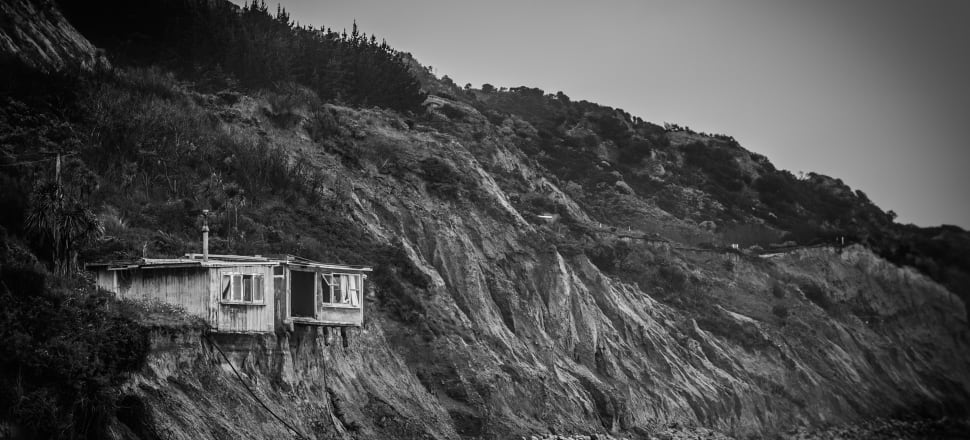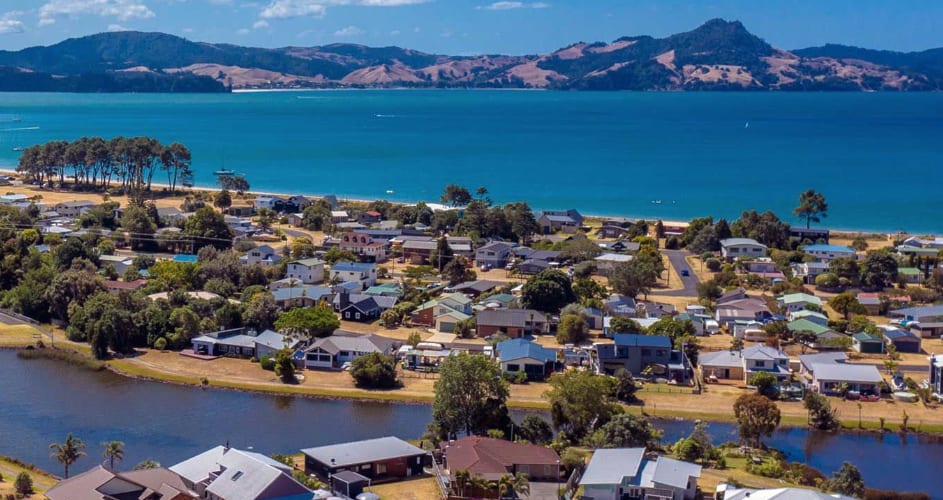
Large-scale, climate change-related relocation of people from the coast and flood-prone areas is inevitable, according to a panel of experts. Politicians must make tough decisions on when people have to abandon their homes, and how to compensate them. | Content partnership
No one in the room was using the word “if” when it came to “managed retreat” – the coordinated process of moving people and property at risk from climate change-related hazards out of harm's way. It was all about “when”, and what to do about it, preferably before a disaster happened.
The three New Zealand climate change experts gathered at law firm Bell Gully to discuss “What happens as the water rises”, were unequivocal in their view.
Those grim pictures of Westport under water – again – were a preview of what is going to happen with increasing frequency in more New Zealand communities as global warming causes sea levels to rise, and more intense storms bring more flooding more often.
Defence (seawalls, for example) and remediation (lifting homes on stilts) might help in some places for a certain length of time.
But in the end, as Tony Randerson, chair of the government’s Resource Management Review Panel, the body that proposed what is now being known as the Climate Adaptation Act, said at the managed retreat event: “The point will come where homes become uninhabitable and homeowners will be forced to leave and live elsewhere.”
And people won’t be able to rely on insurance companies to cover the costs, Randerson said.
“The inevitability of sea level rise means there is nothing unforeseen or sudden about it and insurers are likely to be unwilling to cover loss from this source.”
Higher premiums and increased excesses for flood damage are a likely first step in some areas, but as a one-in-100-year probability event becomes a one-in-50-year or a one-in-20-year risk, insurance companies will refuse to cover certain properties, or even whole neighbourhoods.
If not insurance companies, then who will compensate homeowners for loss or damage to their properties?
The Government has talked about a publicly-funded insurance scheme for uninsurable areas - similar to what EQC provides for earthquake victims, although EQC doesn’t cover uninsured homes.

But as Belinda Storey, managing director of Climate Sigma and a senior research fellow at the NZ Climate Change Institute at Victoria University said: “Public insurance does not reduce risk, just transfers it to the state.”
“Managed retreat is the only thing that permanently reduces risk - and therefore cost. That is the only thing which doesn’t hand on cost to future generations.”
But managed retreat is a thorny and unpalatable issue. How do you judge future risk to someone’s home from a high tide storm surge made worse by several centimetres of sea level rise? How do you predict who is at risk from climate change-impacted rainfall which might flood a valley or a town? And when it might happen? What if someone’s house is safely on high ground but the local council decides sea level rise makes it unjustifiably expensive to repair the only road connecting it to shops or medical facilities. That’s a very real question for settlements like Eastbourne in Wellington’s eastern suburbs.
Storey says much of the scientific evidence is already there, particularly when it comes to sea level rise. However there is less confidence from experts around future rainfall patterns, and far less confidence around how storm surges are going to be impacted by climate change.
The NZ SeaRise Te Tai Pari O Aotearoa programme, hosted at Victoria University and involving researchers at NIWA and GNS Science, has produced specific projections out to 2300 for every two kilometres of the New Zealand coastline, combining sea level rise and ‘vertical land movement’ - whether a particular bit of coastline is rising or sinking. This allows people living on the coast to check the risk to their individual property using an interactive mapping tool.

For example, the tool suggests there could be 30 centimetres of sea level rise in some areas of Wellington, Auckland and Christchurch as early as 2040. In Akaroa on Banks Peninsula, “30 centimetres of sea-level rise means the one-in-50-year coastal storm flood will occur annually,” NZ SeaRise programme co-leader Professor Tim Naish told the Christchurch Press.
Even a one-in-20-year probability of a flooding event would make properties uninsurable, or lift flood excesses to potentially unaffordable levels, Belinda Storey says.
And in many areas of the country a 30cm lift in sea levels would make a lot of essential public assets, from roads and sewage treatment plants, to schools and medical facilities, untenable.
“There’s enough information to allow us to make early decisions,” Storey says.
Still the decisions are far from simple. Panel moderator, Bell Gully partner Natasha Garvan, said successful adaptation would require an understanding of not only the climate science but the forces that will determine the response. This will include the legislative environment currently being shaped, the behaviour of property and other markets, and the extent of community and political support for adaptation.
“The changing legal landscape presents us with an opportunity to address these challenges,” she says.
“There are a lot of very thorny issues to be determined,” Tony Randerson told the Bell Gully seminar. Do we give authority for Government or local authorities to move people if necessary? And do we have funds to compensate people who have lost homes and had to move?”
The thorny issue of compensation
Professor Jonathan Boston is a public policy expert at Victoria University of Wellington and is preparing a report, due for release in early December, on the policy options for addressing private property losses in the context of managed retreat.
He says planning for managed retreat should be proactive, precautionary, multi-generational and cross-party, and that the issue of compensation will be critical.

“We must avoid short-termism at all costs. We have to have a national conversation and involve people, getting them to understand what the issues are and how we are going to proceed.
“If we aren’t sufficiently generous, too many people are going to say ‘This isn’t fair’ and that is going to make it too difficult to move people. There is going to be a feeling ‘the Crown has stolen my land and given me nothing’ and there will be more protests outside Parliament.”
“Ad hoc, muddled and ineffective adaptation responses to climate change pose huge risks to the future of democratic governance." – Jonathan Boston, Victoria University
It’s what keeps Boston awake at night.
“Ad hoc, muddled and ineffective adaptation responses to climate change pose huge risks to the future of democratic governance.
“Securing and then retaining multi-party support for a public compensation scheme is vital for long term policy consistency and intergenerational fairness.”
In a paper published in October, Boston presents several possible options for a public compensation scheme, all with advantages and disadvantages.
The most generous option, which mirrors a model being pondered by the Canadian government, is to “ensure no one is made worse off as a result of a buyout”. Compensation would be enough to cover the purchase of a “comparable property in a comparable neighborhood, but in an area with less risk”, the proposal suggests, as well as offering money to cover moving costs and legal fees.
The downsides include the huge expense associated with the government buying everyone’s house and land, and the bias towards people with property - potentially wealthy people with property.
“Generous buyouts, including of expensive holiday homes or rented apartments, funded via general taxes, would rightly be regarded as unfair by many of those with no property and little prospect of ever owning a home,” Boston says.
Caps and customisation
A fairer scheme would involve setting a price cap on payouts, potentially based on or just below the average house price nationally or regionally. Setting the cap would be the primary problem, Boston says, with too low a cap likely unacceptable to many homeowners, and also unfairly penalising first home buyers with large mortgages.
A third option, which could be combined with the price cap option, would differentiate between someone’s main home and a holiday house or rental property, offering compensation only for the principal residence. It’s fairer for the 40 percent of New Zealanders who don’t own one home, let alone two, but there are also disadvantages to this option, Boston says.
“Generous buyouts, including of expensive holiday homes or rented apartments, funded via general taxes, would rightly be regarded as unfair by many of those with no property and little prospect of ever owning a home.” – Jonathan Boston
These include: people refusing to leave their properties; owners moving full-time into their holiday homes to get the payout; and the potential for a mass sell-off of coastal holiday homes (presumably to people who would live there permanently) which could distort the property market.
Meanwhile, the government not compensating owners of rental properties could lead to a serious shortage in a place like South Dunedin, where 40 percent of properties are rentals.
“If the owners of these rentals were to lose much or all of their investment, they are less likely to invest in the provision of new rental accommodation elsewhere.”
It’s complicated, Boston says. “At first sight the moral case for distinguishing between principal and non-principal places of residence for compensatory purposes is intuitively appealing. But whether such discrimination can... secure long-term public support and multiparty endorsement is less clear-cut.”
Climate leases
The fourth option, climate leasing, emerges from work by Belinda Storey, which began in 2016 when she was visiting her parent’s holiday home on Cook’s Beach in the Coromandel.
Walking along the beach, she knew she would want to carry on using the house, even though she knew it was doomed. In fact, she could imagine continuing to go there pretty much until the waves lapped at the door.
She thought about the different stages of managed retreat, from insurance retreat, when insurance companies no longer offer cover, through credit retreat (when you couldn’t get a mortgage or a loan), through infrastructure retreat (when local roads, water supplies, schools and medical facilities moved).

And she wondered if she wouldn’t be staying put until the final stages - intolerable risk to life and geomorphic retreat, when a house falls into the sea or the land underneath collapses in floodwaters.
“I thought ‘I will hang on here as long as I can, but no one has quantified what that might look like in terms of the impact on the value of a property over time'.”
Storey did some modelling which suggested properties would hold their sale value for longer than you might expect, with prices for an individual house dropping gradually towards zero as the retreat deadline came close, and only then falling rapidly.
Her compensation model, which she calls “climate leasing”, involves the government offering compensation to convert the ownership model for people with properties in areas zoned for eventual managed retreat from freehold to fixed-term leasehold.
The government would become the owner and would pay a cash price for the home which reflected the value of the property and an estimate of the timeframe before sea level rise or other climate-related risks would make that property uninhabitable.
The longer the term of the lease, the less the government would pay.
So, in Storey’s scenario above where the lease is for 85 years, the government might pay 20 percent of the value of the property, leaving the owner free to sell or keep the home over the next decades.
Where the climate risk is higher and the home or the infrastructure around it is expected to be viable for only 50, 25, or even 15 years, the government would pay more - 30, 45 or 60 percent in Storey’s scenarios.
The merits of the climate lease compensation option include giving homeowners flexibility and choice around whether they want to get out of their house early and move somewhere else, or whether they are happy to stay in the home until its value drops to zero, Boston says.
A variation on the model could see the government ‘buying’ an option to purchase the properties in an area zoned for retreat, with the option being triggered either by an event or the owner deciding they want to sell.
“The Crown would end up owning and controlling the land at some point in the future, but property owners would have some control over when they decided to leave,” Boston says. “Having said this, climate leasing faces a range of potential legal, practical, administrative and other drawbacks, some of which are serious.”
Avoiding short-term solutions
And the worst option of all?
That’s government bowing to pressure from local communities in at-risk homes and spending multiple millions of dollars every decade on dykes, seawalls, flooding disaster relief operations and/or a national insurance scheme, and then finding that still wasn’t enough and later having to pay out even more millions in managed retreat compensation.
The US is spending enormous sums on disaster relief and recovery - an early estimate of the cost of insured losses from Hurricane Ian, which hit Florida on September 28, is $US47 billion ($80 billion), making it the state’s most expensive storm ever.
Singapore’s Prime Minister Lee Hsien Loong announced in 2019 the country would spend S$100 billion over the next 50-100 years to protect Singapore from rising sea levels.
Meanwhile, the Netherlands spends around €1 billion ($1.7b) a year on shoring up its flood defences, and that’s without factoring in future sea level rise. The country has around 1000km of coastline, including estuaries and GDP around $1.36tn.
Singapore has less than 200 km of coastline and GDP of $677 billion.
New Zealand has around 15,000km of coastline and GDP of $360 billion
On a dollar of GDP per kilometre of coastline measure, Singapore comes in at $3.4 billion, Holland at $1.3 billion and New Zealand at $0.024 billion.
Why Singapore can build sea walls: GDP per kilometre of coastline
New Zealand just doesn’t have enough money.
The cost of the July 2021 floods in Westport were estimated at $200 million; the town was back under water in February this year.
A proposed $54 million flood scheme will protect some parts of the town, but not all, news reports said, and the risk for the town from its position between two flood-prone rivers will be heightened over the next 20 years by a 20cm rise in sea levels - the third side of the water triangle around the town.
Storey has calculated when flooding in Westport becomes an annual event, the annual insurance premium needed to cover a $1 million property with a $500,000 home on it would be around $100,000.
The calculation for the annual insurance premium required would be the same for any similarly-priced home in any other town where flooding once deemed to have a likelihood of once-in-100 years, became a potentially annual event.
“A very generous scheme will be fiscally costly and would raise serious equity issues; but a scheme that is too miserly will be ineffective." – Jonathan Boston
If the government established a national insurance scheme for flooding along the lines of EQC, it would be the taxpayer meeting the cost of that $100,000 insurance premium.
“Does it make sense to be spending $100,000 on a house in Westport every year to continue to provide insurance cover, let alone the cost of building a stop bank,” Storey says.
“Humans have not risen to the challenge of climate change and the consequences will be costly,” Boston told the seminar. “But people will not want to move - it’s going to be a really gnarly issue.”
Compensation will be key, he says. “A very generous scheme will be fiscally costly and would raise serious equity issues; but a scheme that is too miserly will be ineffective; it will increase the demand for protection and exacerbate the long-term societal costs and risks of climate change.”
Bell Gully is a foundation sponsor of Newsroom








